With a passion for classic tractors and in particular the Fiat 110-90 from a very young age, it was only a matter of time before Owen Hester got his hands on one of the sought-after tractors for himself.
“I always had a soft spot for the Fiat 110-90s, they are a brilliant machine. It’s a tractor you could use to feed a bale of silage without being too awkward, yet have no problem pulling a 14t dump trailer full of sand. Over the years I often drove and admired 110-90s belonging to some local friends and agricultural contractors and always had it in the back of my mind to pick up my own model someday”.
Farming alongside his father Michael just outside the town of Castlerea in Co Roscommon, Owen is a final-year student in Pallaskenry where he’s studying to become an agri mechanic.
After spending two years watching out for a suitable tractor, he found the right machine in Blacklion, Co Cavan, in September 2020. An Irish tractor from new, the 1995 model previously had two owners and almost 8,000 hours on the clock; Owen felt this original version was worth the investment of €17,000. 
Owen estimated that he put well over 500 hours of his own labour into the 12-month long restoration project.
The project
The project kicked off in January 2021 when Owen began removing all of the cab’s interior. This followed the removal of the top and later the bottom half of the cab from the tractor. Despite the fact the cab on later 110-90s were zinc-coated, Owen said there was quite a bit of rust around the sills, especially around the windows. A local fabricator helped clean down and piece the worst of the cab, with it being sandblasted down after. A friend sprayed the cab and panels, while Owen took on the task of painting the rims himself, using a primer and two-pack paint to complete all. 
Upon carrying out 100 to 150 hours of work with the 110-90 before beginning the restoration project, Owen got a good feel for the tractor and took note of several mechanical issues that needed work, including an issue with the gearbox. After splitting the tractor and checking the gearbox, he discovered a piece of a handbrake pad had chipped off and ended up in the dropbox, causing a gear to chip. New brake discs were fitted in the half axles while the handbrake also needed attention, and got new pads and discs. When he was in that far he explained that he replaced the piston seals, as they were letting oil for the brakes into the backend. New pins and bushings were fitted to the front axle while a new radiator was also fitted. The engine always ran perfectly, with Owen noting that it didn’t need any work whatsoever. The final piece in the puzzle is to fit a turbo. Owen has located one and is going to fit it shortly, hoping it will bring about an additional 20-30hp. 
“I’m delighted with how the tractor turned out. Initially, I had only planned to paint it, but once I began cleaning down the cab, I couldn’t ignore the rust issues. There were several mechanical issues that needed to be addressed. While I was that far into it, I said I’ll do it once and do it right and I’m glad I went down that route. It was a great learning curve. My lecturer in Pallaskenry got plenty of phone calls and helped me along the way.”
All parts were sourced from Igoe Agri and Engineering, Garahy Tractors, Tractor Cab Specialists and Tool and Light. 
The cost
Despite carrying out the vast majority of the works himself, the restoration project still cost Owen a pretty pound. Starting off with the cab, the recovery of the badge headliner for the cab cost €250, the black upholstery cost €400, followed by fitting a new air seat (€600) and a new floor mat (€400). The total interior works totalled over €2,000. The existing wiring loom needed serious attention and Owen decided to make one at his place of work with the help of Brennan Harvesting Ltd, a local forestry contractor. This loom, alongside a new set of LED work lights, cost a further €1,000. 
The paint cost €1,000, while the subbed-out labour works including welding and spraying cost a further €1,400. The decals (stickers) cost €200, while all the mechanical parts totalled €6,400. Estimating that he put over 500 hours of his own labour into the project, the restoration amounted to €12,000 in parts. Coupled to the original buying price of €17,000, this means the tractor is standing Owen €29,000. 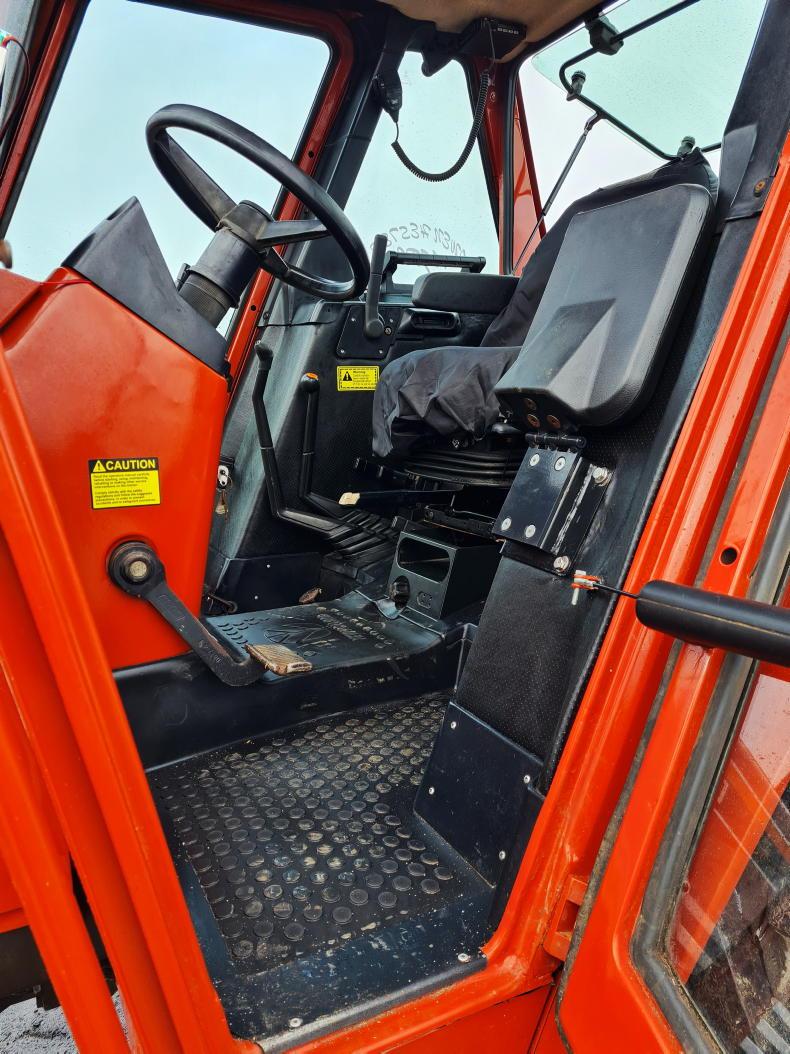
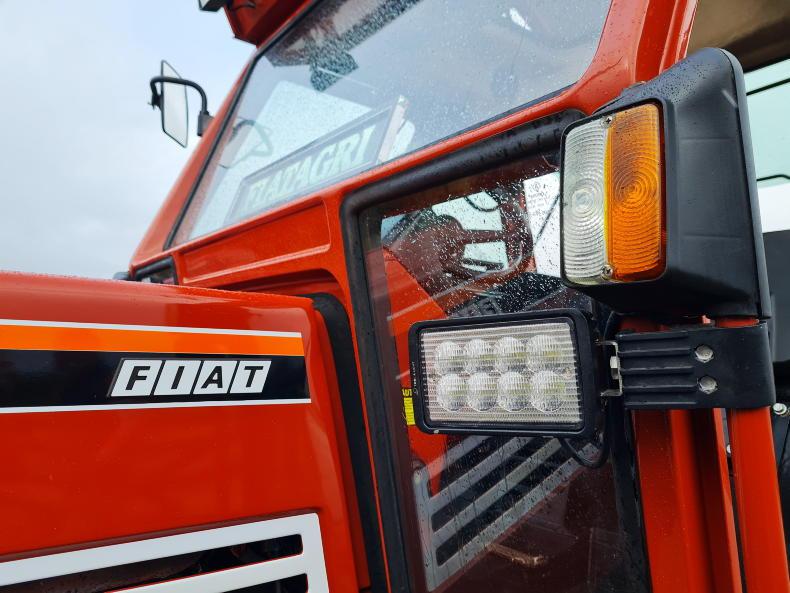
Fiat history
In 1984 Fiat introduced its well regarded 90 series, which replaced the 80 series with a large number of models.
In 1985, the company began producing the “bridge” series, which included the 90-90, 100-90 and 110-90 models. This series introduced a new level of operator comfort with its suspended cab, air conditioning and low in-cab noise levels. The last 110-90 Tradition model was launched in 2002.
In the 1990s Fiat launched the ‘Winner series’. In 1993, it introduced the second series, comprising the F100 and F115 and the two Turbo models, the F130 and F140. The Winner series was followed by the launch of the ‘G’ models, designed for heavy draft works, followed by the launch of the M series. Meanwhile, the last of the 110-90s, branded as Tradition models, were produced in the blue Ford New Holland livery following Fiat’s 80% acquisition of Ford. Both brands later merged to form New Holland and the Fiat Terracotta livery was phased out. Production of the 90 series spanned from 1985 until 2003.
Earlier 90 series tractors were known for rusting around the cab area as they weren’t galvanised which was said to have been addressed from the early 1990s on. Under the bonnet of the 110-90 tractors was a 5.9l six-cylinder Fiat engine which produced 110hp. Not many remained standard, given the engine’s suitability for turbo treatment, with output figures in the region of 150-160hp not unheard of.
The popularity of the 110-90s continues to grow. A price of £67,200 (€80,151 at the time) including commission was paid for an immaculate 2003-registered Fiat New Holland 110-90 Tradition at a machinery auction in January in Co Derry. It’s believed the last of the 110-90s brand new in 2003 would have set you back in the region of €40,000 plus VAT here in Ireland.
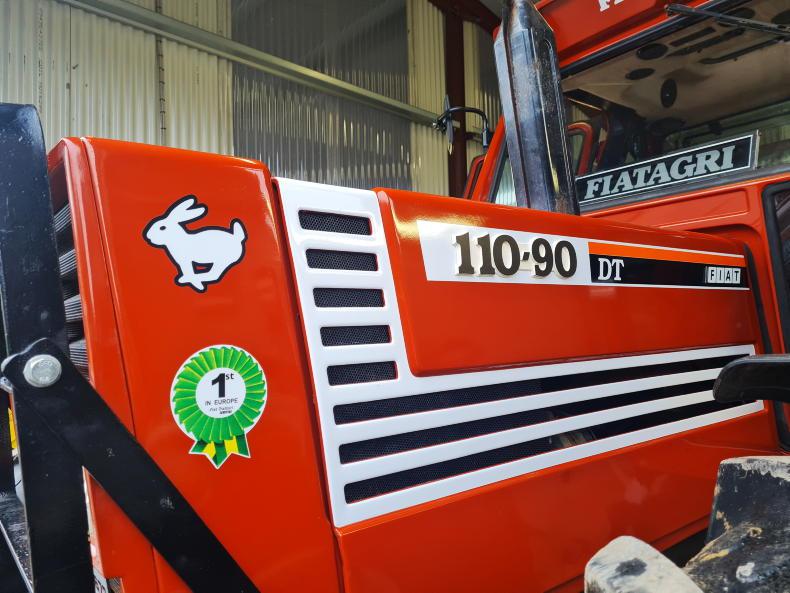



With a passion for classic tractors and in particular the Fiat 110-90 from a very young age, it was only a matter of time before Owen Hester got his hands on one of the sought-after tractors for himself.
“I always had a soft spot for the Fiat 110-90s, they are a brilliant machine. It’s a tractor you could use to feed a bale of silage without being too awkward, yet have no problem pulling a 14t dump trailer full of sand. Over the years I often drove and admired 110-90s belonging to some local friends and agricultural contractors and always had it in the back of my mind to pick up my own model someday”.
Farming alongside his father Michael just outside the town of Castlerea in Co Roscommon, Owen is a final-year student in Pallaskenry where he’s studying to become an agri mechanic.
After spending two years watching out for a suitable tractor, he found the right machine in Blacklion, Co Cavan, in September 2020. An Irish tractor from new, the 1995 model previously had two owners and almost 8,000 hours on the clock; Owen felt this original version was worth the investment of €17,000. 
Owen estimated that he put well over 500 hours of his own labour into the 12-month long restoration project.
The project
The project kicked off in January 2021 when Owen began removing all of the cab’s interior. This followed the removal of the top and later the bottom half of the cab from the tractor. Despite the fact the cab on later 110-90s were zinc-coated, Owen said there was quite a bit of rust around the sills, especially around the windows. A local fabricator helped clean down and piece the worst of the cab, with it being sandblasted down after. A friend sprayed the cab and panels, while Owen took on the task of painting the rims himself, using a primer and two-pack paint to complete all. 
Upon carrying out 100 to 150 hours of work with the 110-90 before beginning the restoration project, Owen got a good feel for the tractor and took note of several mechanical issues that needed work, including an issue with the gearbox. After splitting the tractor and checking the gearbox, he discovered a piece of a handbrake pad had chipped off and ended up in the dropbox, causing a gear to chip. New brake discs were fitted in the half axles while the handbrake also needed attention, and got new pads and discs. When he was in that far he explained that he replaced the piston seals, as they were letting oil for the brakes into the backend. New pins and bushings were fitted to the front axle while a new radiator was also fitted. The engine always ran perfectly, with Owen noting that it didn’t need any work whatsoever. The final piece in the puzzle is to fit a turbo. Owen has located one and is going to fit it shortly, hoping it will bring about an additional 20-30hp. 
“I’m delighted with how the tractor turned out. Initially, I had only planned to paint it, but once I began cleaning down the cab, I couldn’t ignore the rust issues. There were several mechanical issues that needed to be addressed. While I was that far into it, I said I’ll do it once and do it right and I’m glad I went down that route. It was a great learning curve. My lecturer in Pallaskenry got plenty of phone calls and helped me along the way.”
All parts were sourced from Igoe Agri and Engineering, Garahy Tractors, Tractor Cab Specialists and Tool and Light. 
The cost
Despite carrying out the vast majority of the works himself, the restoration project still cost Owen a pretty pound. Starting off with the cab, the recovery of the badge headliner for the cab cost €250, the black upholstery cost €400, followed by fitting a new air seat (€600) and a new floor mat (€400). The total interior works totalled over €2,000. The existing wiring loom needed serious attention and Owen decided to make one at his place of work with the help of Brennan Harvesting Ltd, a local forestry contractor. This loom, alongside a new set of LED work lights, cost a further €1,000. 
The paint cost €1,000, while the subbed-out labour works including welding and spraying cost a further €1,400. The decals (stickers) cost €200, while all the mechanical parts totalled €6,400. Estimating that he put over 500 hours of his own labour into the project, the restoration amounted to €12,000 in parts. Coupled to the original buying price of €17,000, this means the tractor is standing Owen €29,000. 

Fiat history
In 1984 Fiat introduced its well regarded 90 series, which replaced the 80 series with a large number of models.
In 1985, the company began producing the “bridge” series, which included the 90-90, 100-90 and 110-90 models. This series introduced a new level of operator comfort with its suspended cab, air conditioning and low in-cab noise levels. The last 110-90 Tradition model was launched in 2002.
In the 1990s Fiat launched the ‘Winner series’. In 1993, it introduced the second series, comprising the F100 and F115 and the two Turbo models, the F130 and F140. The Winner series was followed by the launch of the ‘G’ models, designed for heavy draft works, followed by the launch of the M series. Meanwhile, the last of the 110-90s, branded as Tradition models, were produced in the blue Ford New Holland livery following Fiat’s 80% acquisition of Ford. Both brands later merged to form New Holland and the Fiat Terracotta livery was phased out. Production of the 90 series spanned from 1985 until 2003.
Earlier 90 series tractors were known for rusting around the cab area as they weren’t galvanised which was said to have been addressed from the early 1990s on. Under the bonnet of the 110-90 tractors was a 5.9l six-cylinder Fiat engine which produced 110hp. Not many remained standard, given the engine’s suitability for turbo treatment, with output figures in the region of 150-160hp not unheard of.
The popularity of the 110-90s continues to grow. A price of £67,200 (€80,151 at the time) including commission was paid for an immaculate 2003-registered Fiat New Holland 110-90 Tradition at a machinery auction in January in Co Derry. It’s believed the last of the 110-90s brand new in 2003 would have set you back in the region of €40,000 plus VAT here in Ireland.





















 This is a subscriber-only article
This is a subscriber-only article






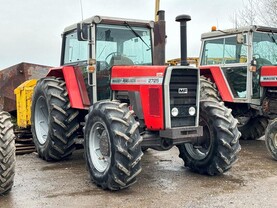

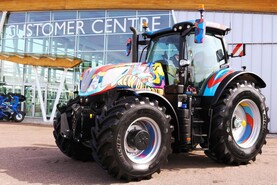
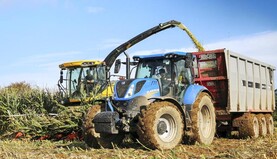

SHARING OPTIONS: